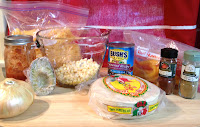
Have you ever noticed that you can buy a huge package of chicken breasts for way cheaper than a small package? And those big packs go on sale a lot. The problem come in that unless you have enough people to eat 5+ lbs. of poultry in one sitting, you may end up wasting more than you save.
Most of the time, I'm only cooking 2-3 chicken breasts at a time but hate to spend more money for less chicken by buying the small pack. When I got my freezer, everything in my chicken world changed! Now, when chicken breasts go on sale, I can stock up without worrying about waste.
Not to mention it's crazy convenient to cook with. Since I pound it out flat before freezing individual portions, I can use as few or as many as I want. I can put a few pieces in the fridge the night before to thaw, put them into the crockpot, or go directly from freezer to oven. Gone are the days of wanting to make something homemade for dinner only to be without any meat (save some cans of tuna).
Here's 10 points on how to home-make your pounded poultry packets:

1)
Buy: - I choose boneless, skinless breasts...best quality for lowest price. (In my neck of the woods, I've found Sam's to be the best option for this. You can get a HUGE package of chicken for about $10.)
2)
Trim: Take the time before you freeze it to trim any extra fat or gross stuff off of your chicken. I have to say this is probably my least favorite part of the process, but I'm always glad I did it after its over. A pair of kitchen shears is super handy for this job, and much less messy than a knife.
3)
Season: If you want to season your chicken before freezing, either with a little kosher salt or something more, this is the time. This is completely optional, and I only do it sometimes.

*Tip: if you're going to thaw your chicken before cooking it, you'll have another chance to season it once it's thawed. If you're going directly from freezer to oven, not much sticks to frozen chicken breasts. You might get some seasoning on the outside layer, but the inside will be kind of bland.
4)
Package: Place your chicken breasts inside resealable plastic freezer bags. I usually put 1-3 pieces per quart-size freezer bag, but you can do whatever works best in your house. Seal it up, leaving about an inch unzipped at one corner.
5)
Pound: Now this is the fun part! Grab a rolling pin, heavy skillet, or even an unopened can of beans and pound that poultry! Flattening it out to about 1/2 inch or so will help it thaw/cook more quickly and evenly and will keep it from taking up extra room in your freezer.
6)
Seal: Squeeze any extra air out of the bag, and finish zipping it up.

7)
Label: Write what it is, any seasoning you added, and the date you froze it on the bag so you'll know what you're getting later.
8)
Stack: Since you've pounded the pieces out flat, just stack them up one on top of the other.
9)
Freeze: Pop the stack in your freezer.
10)
Cook: Whenever you're ready to use them, just let them thaw in the freezer overnight or put them directly into the oven while frozen. Cook them until they're 165'F inside. Serve them with some cut up potatoes and herbs, plain to chop up over some rice or pasta, or coat them with some of the spread I'll share in my next post (It's sooo delicious!).
 I love fresh corn on the cob...the kind you get at the farmer's roadside stands or local produce shops. While the bags of frozen corn on the cob at the supermarket will do in a pinch, they just can't hold a candle to the fresh, unshucked ears. It's a summertime staple around here.
I love fresh corn on the cob...the kind you get at the farmer's roadside stands or local produce shops. While the bags of frozen corn on the cob at the supermarket will do in a pinch, they just can't hold a candle to the fresh, unshucked ears. It's a summertime staple around here. 








































